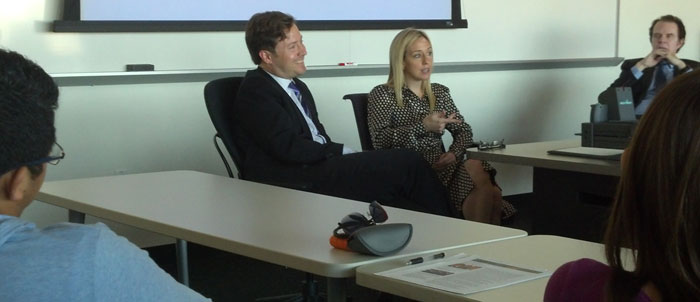Barlett & Steele Silver Award Winner
“The United States of Subsidies”
By Louise Story
The New York Times
It seemed like a simple question: how much money do cities and states spend on business incentives in the name of job creation?
“I’ll get right back to you on that,” I told them, thinking it’d be a quick piece of data to look up somewhere.I was talking with my editors about a grocer in New York called Fresh Direct that had just won a huge package of incentives from the state and city, after a bidding war against New Jersey. We wondered how much money these sorts of deals added up to nationally.
What I found when I started calling around was that it was anything but quick. No one in the federal government asks states and cities to send in tallies of the tax breaks they give out. Nor does the federal government ask about free property given to companies or outright cash grants. Professors I called about this told me they’d love to have such figures, and several had made estimates of the costs of incentives. But they said there simply was no data set on what all these bidding-war deals are actually costing taxpayers.
This could have been the end of my project, but it turned out to be the beginning. It took me about four months to create a tally of the costs of incentives. The first step was figuring out which programs states and cities offered to companies, the second step was requesting one-year costs of those programs from the local governments, the third was recording it in a database I created.

The result was 1,874 programs across the country and the cost for those exceeded $80 billion a year. That was an interesting finding, but that was not the end of my reporting. I wanted to look into examples that would provide context and long-term case studies on how incentives deals tend to play out.
To determine which stories to tell, my editors and I looked to the data. We could see that Texas was the state that gave out the most money on incentives, so I dove into learning about incentives there. We could see that the film industry was one of the top industries getting awards, so that became another story. And, using other datasets that identified companies receiving awards over time, I could see that General Motors has been the top recipient of local incentives. General Motors and its long history of broken promises became the heart of the first story in the series.
Often, investigative reporting is centered on finding out something specific that others are trying to keep hidden from the public. A break-through might come from a secret source providing a trove of documents. This project was a little different because it didn’t involve information that one party was keeping from view. Instead, it involved deals and dollar figures scattered throughout the country that just needed to be collected and tallied. Both types of reporting – source-driven scoops and laborious information collecting – are important, but one thing I’ll say is that sitting in front of Excel all day typing in numbers is not as glamorous as some might picture a reporter’s work to be!
FIVE TIPS:
Here are some tips I’d give to anyone trying to take on an investigative project:
1) Start with a question. If you’re going to spend a lot of time on something, it’s best when you are trying to answer a question that is so interesting that people will be interested in the answer, whatever it may be. It can be rough going to start with a hypothesis, report it out for a long time, then have it not pan out. In contrast, a good question will yield a good result either way. In this project, I knew that people would be interested in the national cost of local incentives no matter what it was.
2) Don’t be deterred by a lack of information. If you find out no one has collected information on a topic of interest, that could be your opening! Don’t be afraid to collect it yourself if it is an important enough area that readers will be interested in your findings. Ask experts in the area in which you are reporting for guidance on things to keep in mind as you collect the information.
3) Go there. It’s great to have a data-driven story, but in the end, stories sing to readers when they are filled with on-the-ground reporting. I learned just as much on the ground in Michigan and Texas as I did from the data. I met people, some whose stories I told, who had lived the incentives experience and you can’t replicate that with data.
4) Be transparent. It’s important to tell readers about your methods and about what you do and do not know, especially when you spend months and months on a project. Put source documents and data online when possible. Engage in conversations with readers via comment areas and other forums when your story is published. We put all the data from my project online, so readers could form their own conclusions on what programs seem worth the money and which do not. I still receive questions on that data – largely from professors using it for research now – and I try to answer them with enthusiasm. In some ways, journalism lives longer now because of the Internet, so it is worth taking the time to put explainers online for the people who will be looking at your findings for years to come.
5) Challenge conventions. On any beat you cover or project you begin, you’ll find that the long-timers in an area have accepted all sorts of methods of doing things and traditional hierarchies. Learn from these old-timers, but at the same time, frequently ask “why?” and “how do you know that?” Sometimes it’s an outsider – a journalist – that needs to come in to spot growing problems or unsupported assumptions. In this project, one of the most common answers I heard from local officials about why they pass out incentives is that the companies say they might go overseas otherwise. When I asked them how they knew that, they’d say, “well, the companies told us that.” But when I looked through data on where companies were considering moving, I found that the majority of companies that received incentives in recent years were only considering locations inside the United States.
PLUS 1) My last piece of advice on investigative reporting is to be curious as well as determined. If you’re curious, you’ll never get bored on the long reporting path, and if you’re determined, you’ll eventually find out what you set out to uncover, and often, far more.











